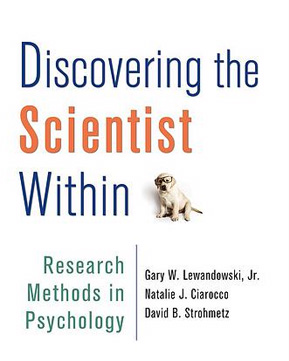
Discovering the Scientist Within: Research Methods in Psychology
An Innovative Approach to Research Methods
- Our Philosophy - Students best learn how to think like a scientist by actually engaging in the research process. As a result, we teach design through example-based chapters, modeling how psychologists use the scientific method to answer a research question.
- A Natural Blend - Scientific discovery involves the interplay of design, statistics, and writing. Yet, many existing curricula and course structures approach these skills in a sequential or modular way that unnaturally separates them. We address this by having students learn design, statistics, and writing side-by-side within each chapter as they answer an interesting research question.
- Emphasis on APA Style - The design chapters emphasize APA style in a unique way by having APA infused into chapters with a example Results section and APA style tables based on the chapter's research question. Design chapters also model elements of APA style by starting each chapter with Lead-In that grabs attention and then turns to a review of the key literature. Each design chapter ends with a discussion of the study that parallels an APA style discussion section. This approach allows students to learn aspects of APA in a subtle, almost gradual way, rather than just separating it out as module.
- Integration of Ethics - Along with a dedicated chapter to ethics in research, each design chapter integrates ethical issues specific to the design and research topic of the chapter. Students learn how ethics plays a role in the development of every research study and how ethical considerations influence any design decision.
- Writing Style - The book uses a conversational writing style throughout that engages students in the material. Design chapters take a story-like approach where the reader is along for the ride as decisions are made about how to best answer the research question.
- Engaging Studies - An important way to capture students' interest in research is by exposing them to creative research studies on topics that students enjoy. In addition to the Research Spotlights, highlighting interesting studies related to the chapter's topic throughout the book, design chapters include findings from several interesting studies to help bring depth to the chapters' research question.
- Thematic Approach - The design chapters have a consistent theme that leads students through a parallel set of 10 steps.
- Unique Content - We include chapters on topics such as qualitative methods and program evaluation that traditionally get less (or no) coverage in undergraduate research methods textbooks.
- Data - We provide data sets for the design chapters, allowing students to conduct their own statistical analyses, comparing their results with the chapter's results. We also provide an additional data set based on a unique research question in the Instructor Manual for each design chapter.
- Communicating the Science of Psychology - Our "writing in APA style" appendix focuses on providing students with concrete suggestions for improving their writing's clarity and conciseness. The appendix also helps guide students through the writing process, including taking quality notes, creating an outline, and revising writing drafts. We provide checklists for adhering to APA style, along with tips for delivering effective poster and paper presentations.
- Unparalleled Instructor Manual - We offer instructors a comprehensive collection of high-quality content that emphasizes active learning within and outside of the classroom. For each chapter, we provide additional concept examples, activities, demonstrations, and group projects, all of which build on the text's content without repeating it.
- Engaging PowerPoint Presentations - We have designed the chapter PowerPoint presentations to promote active learning. Rather than providing text-laden slides that simply repeat information from the text, we incorporate classroom demonstrations, activities and discussion questions into each chapter PowerPoint. To facilitate integration of the textbook in one's course, we have created two different PowerPoint presentations for each of the design chapters. One presentation follows the chapter's research question while and one that focuses on the chapter's design itself.
- Online Modules - We have created online activities that lead students though the research design and decision making process. These modules take the text's approach and allowing students to experience the thrill of doing research.


